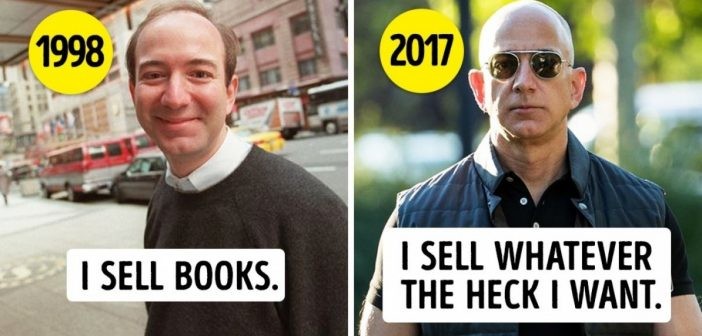
This week, Jeff Bezos was in the news because he stepped down as CEO of Amazon and moved to the position of Executive Chairman. Many people have heard about the American businessman before this. He gained worldwide acclaim when he became the first person in the world with a net worth of over $100 billion. In this article, we will travel back in time and take a look at how he built businesses of enormous scale.
After studying electrical engineering and computer science at Princeton, he eventually went to work for DE Shaw & Co, a global investment management firm. While working there, together with a colleague, he came up with the idea to sell books online. The competitive advantage they were aiming for was that an online store would be able to have levels of inventories unachievable for brick and mortar stores.
In 1995, Amazon.com was launched. However, it wasn’t a financial success right from the start. It took nearly ten years for the business to start reporting any profits. This was part of the strategy, according to Bezos. He convinced Wall Street that they would have to think long-term and that it could take as much as 20 years for the bottom line to be black. This would allow the company to consistently undercut competitors’ prices and put them out of business, resulting in a large market share for Amazon.
Unfortunately for competitors, the strategy worked. Many traditional offline businesses were put out of business by the new online player. Then Amazon.com underwent a large transformation which made it possible for third-parties to sell on the website. This move was a great success as all those brick and mortar stores had all experienced the power of the internet and saw their sales fall. Now those failing businesses could enjoy the power of the internet too and do large revenues online. However, Amazon forced these third parties to agree to high commissions by using shady tactics like removing buy buttons from third-party listings.
Another strategically successful move was the introduction of Amazon Prime. This membership program promised consumers two-day deliveries on their orders for $79 per year. Such fast shipping times were not easy in a country as large as the United States, so many new warehouses needed to be constructed. This brought many jobs to areas hit hard by the 2008 crisis. The warehouses enjoyed a warm welcome where they were built. However, very soon reports would emerge highlighting the bad working conditions in the facilities. Temperatures were way too high and workers were pushed beyond their limits. Amazon itself says the work conditions are great as workers stay at their jobs for years, but the company does not want to share specific details on employee turnover.
With millions of packages being delivered, Amazon saw a possibility for integrating this activity into their business. The company set up a network of contractor drivers to deliver their packages. The network grew fast and competed with the likes of UPS and FedEx. However, as with most major Amazon innovations, there was a dark side to this. Third-party deliverers were encouraged to achieve rates so high that they started taking large risks while driving. This led to many accidents of which some were even fatal. Amazon has always said it could not be linked to the accidents as the drivers were third party contractors.
When Amazon grew even further, Jeff Bezos realized he could rent out part of his digital infrastructure to others. Amazon Web Services, the Amazon cloud business, was born. What launched AWS to be the largest cloud services provider was the fact that the CIA trusted Amazon to build its digital infrastructure. AWS was another innovation that changed the daily lives of many consumers. The platform provides the back-end for many successful businesses like Netflix and Linkedin. AWS expanded Amazon from a company that sells everything to a company that does everything. Warren Buffet calls what Jeff Bezos has built a “miracle”.
Every move Jeff Bezos makes influences the markets. When Amazon announced the acquisition of PillPack, competitors in the retail pharmacy sector lost billions of dollars in market value. The same happened when Amazon announced it was “looking” at healthcare costs – without even implying what that meant exactly. Essentially, Jeff Bezos can hurt competitors without even competing. E-commerce companies can hardly raise money nowadays because the question that always arises is “how can we compete with Amazon?”.
Jeff Bezos is beginning to look beyond everything he has achieved in this world. In fact, he already did so back in school where he was quoted in a high school newspaper saying if the population were to keep expanding, “space is the only way to go”. He is spending a billion dollars a year from his personal fortune on a space exploration program he created. Only the future can tell what these investments will ultimately result in. Jeff Bezos hopes it will allow next generations to live even better than the current generation does. However, we must not forget that many of Bezos’ innovations also know a darker side, with some examples illustrated above.


